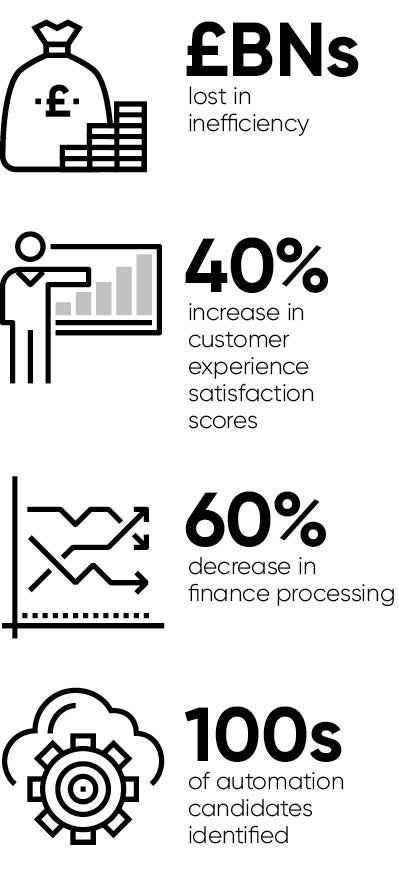In recent decades, many companies have turned to business process outsourcing, offshoring their repetitive tasks to enable staff to focus on high-value activities.
Among Fortune 500 companies, however, it is estimated that every year billions are still lost from inefficiency, and the causes of this can be found in the organisational data and knowledge that remain uninvestigated. This unused information, or “dark data”, resides within every company in its enterprise resource planning systems and other applications.
As businesses of all types become increasingly intolerant of this inefficiency, many are turning to robotic process automation (RPA), allowing them to use machines to do repetitive and increasingly complex work.
There are huge benefits on offer. “The businesses we work with can achieve up to a 40 per cent improvement in customer satisfaction scores, improving their financial results through a 60 per cent cut in process times, directly from RPA,” says Mahesh Shah, vice president and general manager of business process services at DXC Technology. Other benefits include better process accuracy and ease of compliance.

Globally, this represents billions of dollars of opportunity, with RPA making life easier for individual employees and whole departments. It helps people do their jobs, eradicating repetitive tasks and enabling focus on more skilled work.
Describing it as the next industrial leap in technology-powered productivity, after the PC and mobile phone, Mr Shah says RPA enables repetitive functions to be handled at all hours, slashing process cycle times. It also enables tasks to be carried out at a fraction of the cost, sometimes one third to one sixth of the expense associated with human labour.
That is only part of the picture as when the technology is combined with artificial intelligence (AI), it can learn the decisions humans would make, enabling it to take on much more complex work, moving from rules-based to intelligence-based processes.
“Artificial intelligence has a compound effect on RPA, constantly learning and driving improvement,” explains Mr Shah. “While today companies might look to use RPA for anything repetitive, over time they can use it to learn and thus make decisions, improving the outcomes of the process.”
Typically, many firms begin with RPA handling repetitive tasks, such as basic checking of invoices, paying them when verified and updating the ledger. Similarly, it can help with profit and loss recording.
Over time, however, they use AI to take on more complex processes in which judgment is required, including understanding requests and issuing appropriate approvals.
Eventually, given the quickly increasing power of AI and analytics, many highly complex tasks will be computerized. Mr Shah says: “Down the road, really complicated decisions such as diagnostics by radiologists at a hospital could be automated.”
Naturally, all of this automation will have an impact on labour, as with earlier stages of industrialisation. But Mr Shah is confident that rather than simply replacing jobs, automation opens up new opportunity. “In the short term, there will be some contraction,” he says. “But RPA also enables people to operate alongside the machines and use their greatest skills much better.”
Applying artificial intelligence to RPA gives companies a step change in their efficiency, strongly improving their bottom line
DXC Technology works with a number of clients in this area, including a global consumer goods enterprise, which undertook a finance and human resources automation assessment project to develop and implement RPA to increase operational efficiency. An assessment of the company’s processes and related technologies identified hundreds of potential automation candidates, covering the workload of several hundred people. Of the potential processes, more than 50 per cent offered autonomous automation.
Before automation, all steps were performed manually, including efforts associated with error handling. Following automation, the steps were automated end to end, with DXC easily handling peaks and troughs in volume as they occurred by adding or removing robots. This resulted in decreased cycle times for these processes by up to 40 per cent, improving quality and negating the management of peaks with permanent resources.
For businesses of all types wanting to make the most of RPA, it is essential that they start at the beginning, understanding their processes and dark data, simplifying processes and automating parts iteratively, while ensuring proper controls are in place. They often begin in areas such as finance, human resources or sales lead handling.
Eventually they shift to more complex processes, such as involving AI to improve personalisation and measure sentiment. One industry doing this effectively is the travel sector, where some hotels predict which customers are likely to turn up in the next few hours, such as a family with children, equipping a concierge with information to recommend relevant and personalised activities.
Businesses shouldn’t see RPA as a silver bullet, but an area that can work well with the right expertise and systems in place. Mr Shah explains: “The benefits from RPA are massive, but the risks can be high too. When not executed well, it compounds the effect of inefficiency. Businesses should work with an expert partner if they want to succeed, doing it at scale.”
DXC Technology takes a detailed approach to introducing RPA in businesses. Typically it first analyses their processes and data flow. “Many companies want to be simpler, faster and cheaper but they miss a lot of the dark data that details the inefficiencies we can fix before automating. Getting this right first is essential,” says Mr Shah. The company only applies RPA once the data and processes are properly analysed and improved; then, as a final step, it adds AI.
“Every now and then, technology comes along that is a real game-changer for businesses,” Mr Shah concludes. “Applying artificial intelligence to RPA gives companies a step change in their efficiency, strongly improving their bottom line and visibly changing the quality of service they can offer.”
To find out how to use robotic process automation successfully in your business please visit www.dxc.technology/business_process_services

